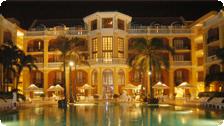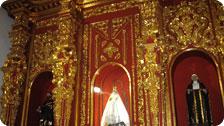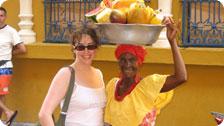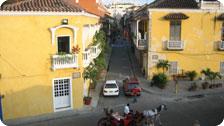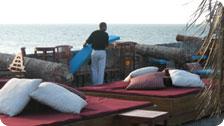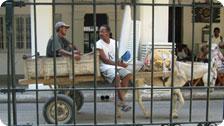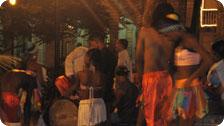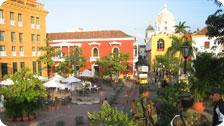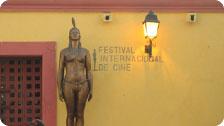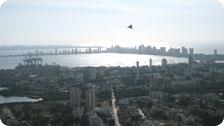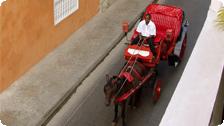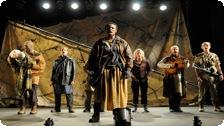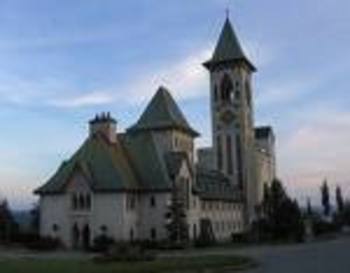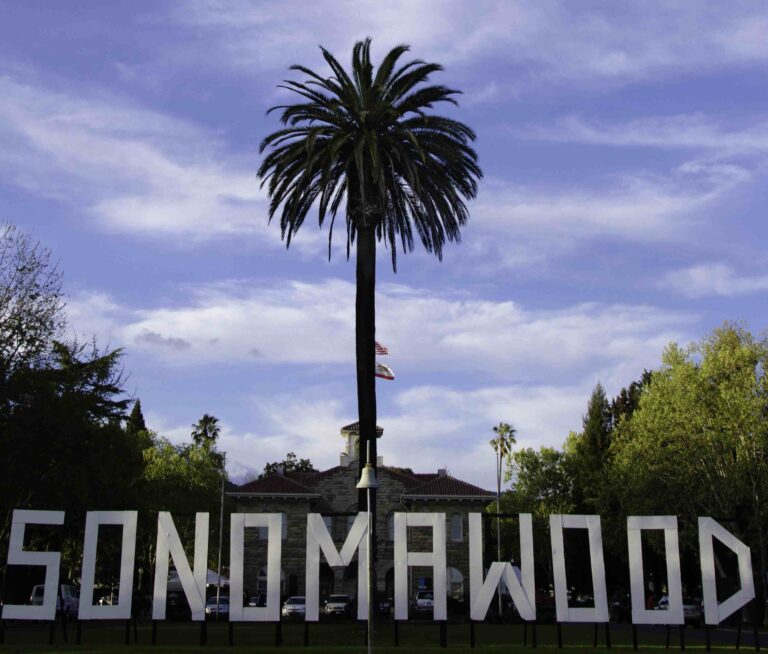Culture: Cartagena, Colombia: The Feeling of Safety
by Stephanie Block
Kidnapped. You’ll be kidnapped. Cartels will kidnap you. Cocoa and kidnapping, the druglord breakfast cereal. The prize inside the box is you, bound and gagged, wishing you’d gone to South Beach instead.
This is how Colombia perched in my mind; a clawing bird ready to imprison me in its bleak and powdery nest. Cocaine cocaine cocaine. My life worth less than a gram. I would never go to Colombia, would never want to go to Colombia. I want to see a hundred countries in my lifetime but not Colombia and her cohorts like Syria, Iraq and Somalia. Those kinds of places.
I wouldn’t even go near Colombia. In Panama, where I was vacationing, even the rainforests that bordered Colombia were off limits because of the guerrillas and kidnappers lying in wait like harpy eagles ready to snatch people away. I was not going in or even near Colombia.
Ever.
But sitting there in the small, air conditioned travel agency, I was getting frustrated. Panama’s famous Caribbean side beaches like Bocas del Toro were totally booked. So were the little islands off Nicaragua. Uruguay, which sounded exotic, was seven hours away by plane, and those flights were booked. My restless spirit bucked and whinnied-let’s go somewhere exciting! Oh Panama, you had a man with a plan-you are a beautiful bridled horse and I can drink your tap water with abandon!
I wasn’t away enough, does that make any sense? I was treading on treaded pathways, looking where eyes had long looked. There had to be someplace else.
“Well,” Alba Ducreux, Ejecutiva de Ventas, said with the patience of the local saints. “There are a few seats left on the plane to Cartagena.”
Cartagena… it’s one of those words. Like a new spice or fruit. I was having an Eve moment; here was something tempting. What should I do? Yes! I booked my flight to Cartagena.
My fruit’s full name is actually Cartagena de Indies, to distinguish it from the other Cartagena. I found this out when I went back to my Panama hotel, googled my fabled destination, and fell in love with the photos, photos from Spain. No, this Cartagena, my Cartagena, was of the Indies, so named because of that man who went looking for India and refused to ask for directions.
There was only one hotel room left, too. Talk about a busy continent for the holidays-South and Central Americans were certainly on the move! Kidnappers’ convention? The only hotel with availability was the Sofitel Santa Clara, and the only room in that hotel was a suite for hundreds of dollars a night. Reviewers on the Internet raved that it was the most romantic place they had ever stayed, the best hotel in all of Colombia.
Which gave me a thought. Surely there would be the best security at the best hotel in Cartagena, but it would also be the most conspicuous place too. Would it be better to stay in a cheap hotel (never!) and get kidnapped because of its lack of security, or to stay in the best hotel and get kidnapped because it is the best hotel?
Luckily, the decision was made for me. I had the best room at the best hotel. At least I’d be going out in style. Isn’t that Tango Diva Rule Numero Uno?
The quick Copa Airlines flight was barely an hour, but I felt, as the plane edged its way along the coast, that I was moving far, far away. My poor family had gotten the email by now, “Slight change in plans… don’t be mad but I’m going to Cartagena, Colombia for a couple days. I’m not sure if I’ll be able to call or write. Happy Holidays, Love, Stephanie.”
My friends had gotten emails, too. I pictured them cheering me on from our favorite bars in San Francisco-“Heh, heh, what do you think Stephanie’s doing right now in Colombia? Heh, heh. She must be partying her aaasssssss off!”
And here I was on a plane to Colombia not knowing whether my ass would be partying or languishing in some dusty militant’s basement.
But here was a clue. I kid you not: There was a guy in the customs line in front of me, amid the stern narcotico soldiers and drug sniffing dogs, wearing a Scarface t-shirt. A Scarface t-shirt. His companion had a bright, big American flag beach umbrella slung over her shoulder. And here I had been practicing my Canadian accent, eh!
I watched to see whether they would get kidnapped on the spot. What I didn’t realize was that our customs officer was a teenager in flip flops. Colombia didn’t make any sense.
I have to admit that I’m a cat person, but I was relieved to see a big dog and an armed guard at my hotel’s entrance, one of the most beautiful hotels I have ever seen. It had that unmistakable feeling of authenticity, blending into the bright Old City area as it would have 500 years ago in its first life as a monastery. There were still vestiges of the cloistered nuns around every burnt orange corner, the hidden confessionals with tiny fences for faces, the remarkable artifacts preserved in cases around the lush courtyard.
There were boldly colored fresh juices at the morning buffet whose repulsive colors hid their marvelous flavors-the gray of the fresh guava, the putrid green of the ripe kiwis. And yes, the women. Scores of super-modeline women dotted the grand pool like so many water lilies, impossibly gorgeous, perfectly wrought and impeccably dressed. Colors and beauty at every turn. Even the local toucan who lived in the courtyard was a rare and rainbowed thing.
No wonder Gabriel Garcia Marquez owned the house across the street (his book, Love and Other Demons, is about the hotel’s history and legends).
My suite, La Abadesa, had been the Mother Superior’s room, its 20-foot ceilings built for luring heat away from my body. But the AC did that now. And bless them-they had tried to add a bathroom to the ancient room by concocting an odd orange and blue wall that cut across the back of the room, a wall that did not meet the ceiling. Which meant that the shower was drafty, which was too bad because the water always ran cold.
What was five star about the hotel was its history, its empty crypts and chapel without altar that you could rent out for parties. Its wonderful location and the sociable wicker chairs under the shade of the balconies. And of course the pool and spa, glorious treasures to which some locals were able to pay to belong like a country club.
Hotel, hotel, hotel, you say. What about Cartagena? Well, Divaismas, there was still that lingering feeling that kidnappers were everywhere, so on my first night, I didn’t venture very far. Right outside my hotel, the street had turned into a bright plaza full of café tables, artists, street vendors, and young men selling Cuban cigars. Under the watchful eye of my armed and canined guard, I sat and had a fine meal. Okay, so the sushi place was the only restaurant with a free table, but of course I only ordered cooked things. And bottled water. After all, this wasn’t Panama anymore.
x
I even bought what was probably a fake Cohiba and let my smoke rings mingle with the festive crowds and handsome jewelry merchants. The streets were full of people, and of course that meant gorgeous people dressed to kill. If kidnappers were indeed lurking in the shadows beneath all the Christmas lights, they wouldn’t know whom to nab first. Everyone: mothers, grandmothers, children; everyone was dressed sexily, brightly, drawing attention to their tanned, taut bodies and Hollywood fashions. In fact, there was only one quiet, inconspicuous, carefully dressed woman around, and she was me.
Could the State Department and CIA be wrong?
The next day, I dared to venture further away from the hotel. You won’t believe what I found. Shops full of emeralds. Plaza after plaza! Old churches and art museums and galleries. I started calling it Artagena. Balconies bursting with flowers. And around this whole quarter like a ribbon on a cakebox was an old stone wall that had protected it for hundreds of years. And on top of that wall, because no one had been around to invade lately, a hot nightspot had sprung up called Café del Mar, yes, like Ibiza. And here the fashionable gathered. From the top of the wall I could see the many horse-drawn carriages circling the city below and the sea beyond.
The nearly equatorial sun bore down. In the afternoon, I asked my hotel to find me a guide. After all, it was my last day and I had only seen the Old City. Going outside the walls?? Dios mio, I was getting bold! The hotel fixed me up with Marelvy, a fluent English speaker who used to be a dancer in Paris and now lived with her artist husband here in Cartagena.
In four hours, she showed me everything from San Felipe Fort built in tandem with the stone wall to La Popa Monastery at the top of a hill from which Cartagena dazzled below in all her old and new splendor: the sea, high rises, and Old City’s pastel churches and plazas. We glimpsed the statue of La India Catalina standing proudly in a traffic circle, a lone feather adorning her head. And finally back to the old city for the best emerald and filigree jewelry shops near the Palace of the Spanish Inquisition where tortures had been meted out with glee.
Walking back to my hotel, we passed a group of dancers in a plaza showcasing the rich cultural heritage of Cartagena. They started with a traditional Latin dance and suddenly threw off their Flamenco-like skirts to reveal long legs and not much else beneath. Then the African drumming started and their hips trembled to its beat.
“This is how I used to dance,” Marelvy said, watching the young dancers and their bionic backsides, thinking perhaps of Paris.
My plane back to Panama City left early the next morning. The morning after that, I would be heading back to California. On the plane to Panama, the first of many in the next 24 hours, I knew that I had changed. So many times I had left my nest to travel. But this was the first time that I had strayed so far from the travel warnings of my country. I had gone to a ‘bad’ place, a dangerous place. A place where my government clearly did not want me to go. And it had been beautiful and I had loved every minute of it and every old stone within it.
And now I was free. The veil of propaganda lifted, the entire world opened up to me. I had overcome fear, the opiate of my masses. Don’t go to Colombia. You won’t come back, which was true. The old me was not on that plane, so in a sense a part of me had been held against its will. I had played no game of Narco Polo. Hadn’t fed the guerillas in the zoo of counterinsurgency. Cartagena was built for love, built to protect and embrace within its firm ancient walls, sheltering and nurturing its vibrant, cultured, beautiful, creative spirits.
And it certainly had its hold on me. As I stood in front of my own country’s customs agents many hours later, and watched for a reaction to that stamp in my passport like a scarlet letter on my chest, I had this thought: I love Colombia! Stick that in your top secret memo and shove it! Sweet teenaged rebellion as delicious as grim guava juice filled me as I took my first independent strides away from my parent country. Intoxicated. Alive and awake and in love with Cartagena. This must be the drug that my country didn’t want me to traffic. And there I was fulfilling my intent to distribute.
* * * *
Editor’s Disclaimer:
I’m not saying you should run off half cocked to Cali or get hell-bent on being in Bogota by yourself like writer Suzanne Siegel. I’m just saying that if the world is a classroom where the teachers play favorites, I am a better person for having made friends with one of the “bad” kids.
* * * *
Stephanie’s Counterinsurgent Cartagena Guide:
Mostly Covering the Cuidad Antigua, Old City, El Centro, or whatever you like to call it:
I’m not the only one in love with Cartagena. It is a UNESCO World Heritage Site and home to hundreds of years of insanely preserved Spanish Colonial architecture, from a time when Cartagena was the main port from which pirates and plunderers shipped the New World’s treasures back to the Old World. Spanish galleon ships lay in their graves on the Caribbean Sea floor for divers to see.
A note on getting around: Unlike Tokyo where the streets have no names, the problem here is that the streets have too many names! They change aliases block to block, as the gorgeous tiled street signs on buildings will attest. You’ll need a good sense of direction for the winding streets and perhaps a beginner’s handle on Spanish-as in ‘donde estan los emeralds?’
Hotels:
Hotel Sofitel Santa Clara: dare to indulge in this beautiful hotel! Full of history, revelry and fine delicacies-the pool scene is a drool scene and you can find the original gilded altar from its chapel-turned-party-room at La Popa Monastery. Be sure to grab some white candy coated almonds that sit in a large clay pot on the desk of the money changers. Oh, and if you have extra time, why not take advantage of their private Caribbean island??
Charleston Cartagena Hotel: also a converted and restored monastery of the 1600s, and also as sumptuous as the Sofitel.
Carrera 3. No. 31-23, Centro Plaza Teresa, Cartagena, Colombia.
Casa del Curato: This is where Marelvy puts her visiting guests up. Small, nice, and cheaper than the Santa Clara, they have a little terrace where live music sometimes takes place. Also located in the Old City.
Super Cool Cocktails:
Hang out at Café del Mar! Baluarte de Santo Domingo, Centro Historico. You can’t miss it-it’s on top of the Colonial wall that rings the Old City. Just ask.
Shopping:
Emeralds: Emerald Plaza Jewelry Factory. Emeraldplaza@joyeriaemeraldplaza.com. Centro, Plaza de la Inquisicion.
Gold and silver Filigree: Filigrana Mamposina designed by Claudia Zuluga. Palacio de la Inquisicion Local 2 Centro, Plaza de Bolivar.
Cold ice cream on a hot day-and who does coffee ice cream better than the Colombians? Crepes y Waffles in the Old City. Be sure pay in advance for your ice cream ticket before you approach the delicious ice cream counter in the back.
Artagena:
Modern Art Museum: the exhibit I saw was about Colombian native Fernando Botero, whose ample statue of Gertrudis lies languidly in the plaza outside. It is considered good luck to fondle her nipples.
Art Cartagena: December 27 – January 15. Every year, the best local craftspeople in the country are selected to sell their wares at the Claustro de la Merced in the Old City. Discover painters, sculptors, ceramic makers, weavers, wood and gourd workers and more! Look for Rosaura Ancinez’s (rosauraancinez@hotmail.com) hot denim stylings and Claudia Fernandez’s amazing glass jewelry.
The Ultimate Tour Guide:
English, French, and Spanish speaking Marelvy is the ultimate guide for hire.
Marelvy Pena
marepenahall@hotmail.com
6663991 Tel
315-7605034 Cel
Sights:
Outside the Old City:
San Felipe Fort
La Popa Monastery so named because it resembles a poop deck
The Diva of the Old City-La India Catalina
Inside the Old City:
Hotel Sofitel Santa Clara
Palace of the Inquisition
The old Colonial wall that wraps around the old town
Take a little horse drawn carriage around town. If you speak Spanish, great, and if not, just smile and nod as the driver explains the sights.
Best Time to Go:
After the rainy season ends, which means the high season of December and January – it’s still hot but things are lush. And this is when the parties start! Do make your reservations in advance.
Calendar:
November-Carnival Cartagena and Colombian Independence Day
New Years Eve in Cartagena is beyond festive with reveling crowds and music in the streets!
January 6-bullfighting season starts
January 25-February 2nd-the festival of Cartagena’s own virgin saint starts
February 2-Feast of the Virgin of Cartagena
March-Cartagena International Film Festival
Discover more from Tango Diva
Subscribe to get the latest posts sent to your email.
